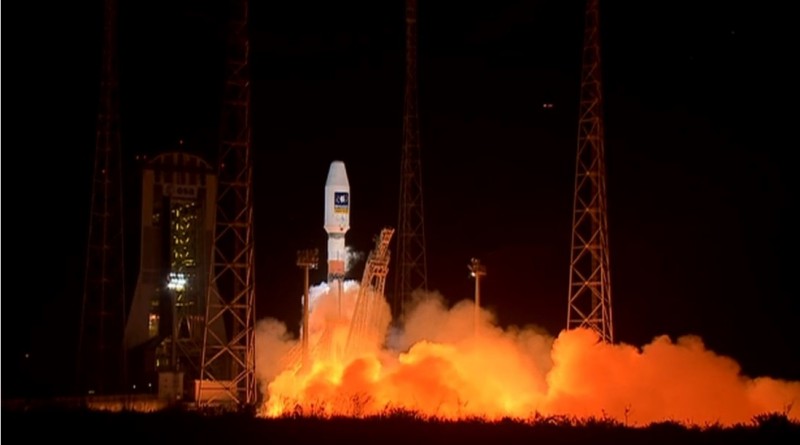Next Galileo Satellite Pair enters Orbit after successful Soyuz Launch
Originally published September 11, 2015
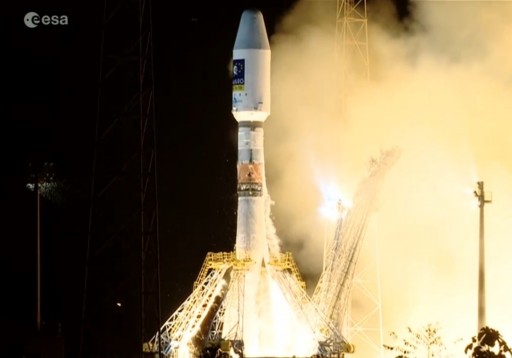
A Soyuz rocket thundered into the early morning skies over the Amazon on Friday, blasting off from the Guiana Space Center on a mission to deliver the next pair of Galileo navigation satellites into orbit in the continued deployment of Europe’s satellite navigation system.
Lifting off from the ELS launch site at 2:08 UTC, Soyuz completed a flawless mission, putting the Fregat upper stage on a sub-orbital trajectory from where Fregat could execute two main engine burns to reach an orbit over 23,500 Kilometers in altitude for spacecraft separation four hours after liftoff.
Spacecraft separation was confirmed and the two newest additions to the satellite fleet, nicknamed Alba & Oriana, began communicating with ground stations – though confirmation of mission success will only come after orbital parameters of the satellites can be confirmed.
The Galileo satellite constellation will provide European nations and their partners with independent and continuous access to global navigation. Because foreign systems like the American Global Positioning System could be shut down in time of crisis, European policy-makers identified the need for an independent navigation system. Galileo, ultimately consisting of 30 satellites in three orbital planes, will offer its highest accuracy to paying customers in governments and the private sector while standard services will be free of charge. The satellite constellation will also deliver global search and rescue services.
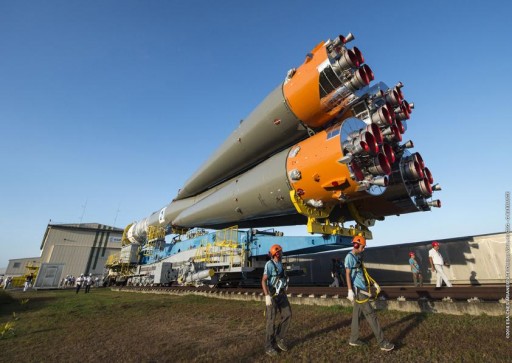
Initial Galileo services are expected to become available in 2016 when more satellites will have taken their spots within the constellation. Launching two at a time on the Soyuz and four per Ariane 5 flight, the Galileo constellation will reach its full operational capability in 2020.
The overnight countdown to the VS12 launch was initiated eight hours ahead of the precisely calculated T-0 time, beginning with the launch team reporting to console to start tracking the progress of preparations for propellant loading that began out at the launch pad. All ground systems and tracking stations were prepared in the hours leading up to the countdown to provide an all-clear status to the team inside the Jupiter Mission Control Room.
A check of weather conditions showed that no interference by the weather was to be expected, allowing countdown operations to commence.
The two satellites were powered up seven hours ahead of launch to go through battery charging, a last checkout and the reconfiguration to their launch mode. Teams at the European Space Operations Center made sure all communication paths to Kourou and the various ground stations were in place, enabling them to receive data from the satellites throughout the countdown and after deployment into orbit.
At the ELS launch site, the first few hours of the lengthy countdown were dedicated to close outs of the Soyuz rocket and ground facilities to set up for the retraction of work platforms in advance of propellant loading. Soyuz and Fregat were powered up for a detailed set of electrical, flight control, communication and propulsion system checks. Also, Soyuz had its engine covers removed and Fregat received its flight software containing all commands to be executed during the marathon mission.
The Russian State Commission, also overseeing launches from the faraway Soyuz launch site, convened at L-5 hours to review the results of launch vehicle testing performed Tuesday and Wednesday and check the status of launch preparations. With no outstanding items, the State Commission gave the formal approval for the launch of the Soyuz, allowing the vehicle to head into propellant loading operations.
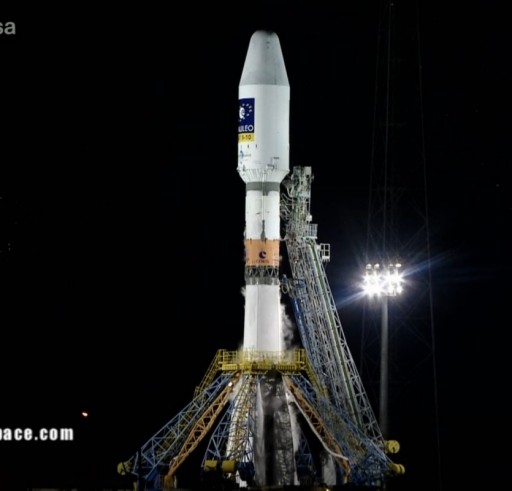
Propellant loading commenced inside L-4 hours when the launch pad had been cleared by non-essential personnel. Liquid Oxygen systems went through a brief chilldown sequence to condition transfer lines and tanks before the -183°C oxidizer started flowing into the boosters, core stage and third stage of the Soyuz rocket. Kerosene loading picked up around the same time and Soyuz also received Liquid Nitrogen to act as pressurant gas on the boosters and core stage while the modified third stage received Helium to serve the same purpose.
All in all, the 12 tanks of the Soyuz rocket were loaded with 272,140 Kilograms of LOX and Kerosene over the course of the two-hour fueling sequence that wrapped up when Kerosene tanks had been fully loaded and topping on the cryogenics started to keep them at flight level as countdown clocks continued to tick down.
Starting one hour and 45 minutes prior to launch, Soyuz went through the last round of systems checks including a communications check with the Galliot ground station near the launch site. The Flight Termination System, unique to Soyuz rockets flying from French Guiana, also went through its final test at that point.
The large Mobile Service Gantry – also a unique feature of the ELS launch site in comparison with all other Soyuz pads – began moving away from the fully-fueled rocket 80 minutes prior to launch. Clearing the way for the 46-meter tall rocket, the gantry was parked in a safe position for liftoff and teams headed into the final setup tasks as clocks passed the L-1-hour-mark.
The 308-metric-ton Soyuz activated its flight control system and received the optimized flight software for this mission and launch command power was activated. Hidden under the large payload fairing, the two Galileo satellites initiated their transfer to battery power and launch mode at L-18 minutes.
Soyuz transitioned its Guidance System to flight mode ten minutes prior to liftoff and teams went through a last check of weather and range status. All status panels remained green, allowing Soyuz to head into its Automated Countdown Sequence.
Pressing into the Automated Countdown Sequence at T-6 minutes, Soyuz began running through a highly choreographed set of steps to transition to its autonomous launch configuration. The telemetry system of the Soyuz went to launch mode at T-5 minutes. At the same time, Fregat made its switch to battery power, entering its liftoff configuration.
With four minutes left in the countdown, Soyuz began purging the RD-107A engines on the four boosters and the RD-108A engine on the Core Stage with Nitrogen gas to remove any combustible substances from the plumbing to ensure a clean and controlled ignition. After propellant drainback, the Soyuz tanks closed their fill and drain valves and safety valves to begin the process of pressurizing for liftoff. All 12 tanks built up pressures and Soyuz separated the Fregat and Payload Umbilical, causing a loss of signal from the two Galileo satellites, their signals to be heard the next time when deployed into orbit.
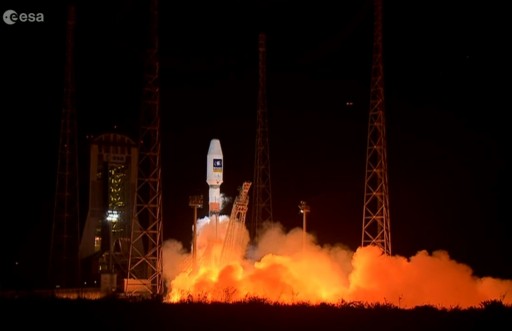
Auto Sequence Start was commanded at T-1 minute and Soyuz assumed control of all vehicle functions, also switching to internal power. The umbilical feeding the third stage popped off and the tallest of the umbilical towers began retraction at T-40 seconds.
Twenty seconds before launch, the command to ignite the engines was issued and the Core Stage Umbilical retracted from the rocket. Spinning up the Hydrogen-Peroxide-driven turbopumps, the booster and core stage engines built up thrust – initially being throttled to an intermediate thrust for monitoring before ramping up to a collective liftoff thrust of 425 metric ton-force.
With its engines rumbling away, Soyuz started climbing from its jungle launch pad at 2:08:10 UTC on Friday, marking the beginning of a long ascent mission for Alba and Oriana, the newest additions to the Galileo satellite constellation.
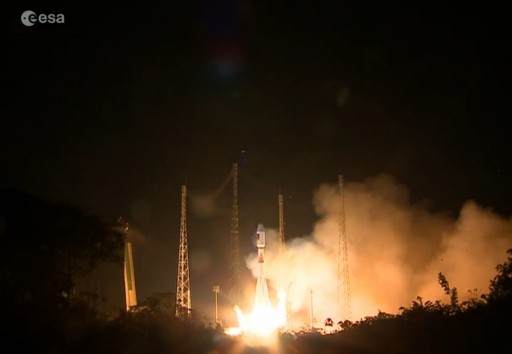
Lighting up the night skies over French Guiana, Soyuz balanced in a vertical posture for ten seconds using its vernier engines that can be gimbaled for stabilization of the launch vehicle. Pitching and rolling, Soyuz successfully aligned itself with its precisely calculated flight path, taking it to the north-east across the Atlantic Ocean aiming for an orbit inclined 55 degrees to either side of the equator.
With its boosters doing most of the work during the first flight phase, Soyuz consumed 1,600 Kilograms of propellant per second, passing through Mach 1 and encountering Maximum Dynamic Pressure just after the T+1 minute mark. Reports from Russian specialists reviewing real time telemetry sent from the Soyuz to the Galliot Ground Station indicated that Soyuz was performing well with good pressures in all engines, good stabilization on the vehicle and normal navigation and control.
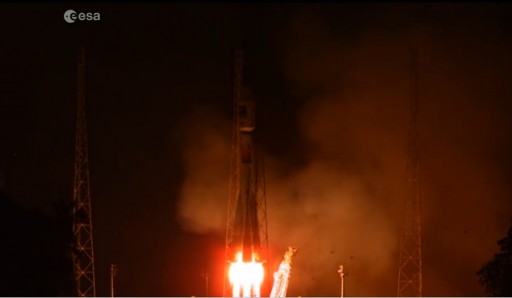
The four boosters kept burning until T+1 minute and 58 seconds when they shut down their RD-107A engines after each burned 39,600 Kilograms of propellants. Immediately after cutoff, the boosters were jettisoned as pyrotechnics separated them and pistons pushed them outward, creating an impressive display of the Korolev Cross in the skies over French Guiana – a phenomenon only visible for a fraction of a second as the boosters rotate outward with the still burning core in the center. Helping accelerate the Soyuz to a speed of 1.5 Kilometers per second, the 19.6-meter long boosters parted ways with the launcher at an altitude of 50 Kilometers, headed for an impact in the Atlantic around 345 Kilometers from the ELS launch site.
With the boosters tumbling back to Earth, Soyuz purely relied on its Core Stage for propulsion, its RD-108A engine burning 320 Kilograms of Kerosene and Oxygen per second to generate 94 metric-ton-force of vacuum thrust.
Heading out of the dense atmosphere, Soyuz jettisoned its protective payload fairing three and a half minutes into the flight when passing 110 Kilometers in altitude. Since the two Galileo satellites and Fregat Upper Stage could no longer be harmed by aerodynamic forces, shedding the fairing allowed Soyuz to lose some no-longer-needed weight to improve its performance heading up the hill. Now exposed for the rest of the way into orbit, the two satellites were sitting side by side atop their specially-built payload dispenser.
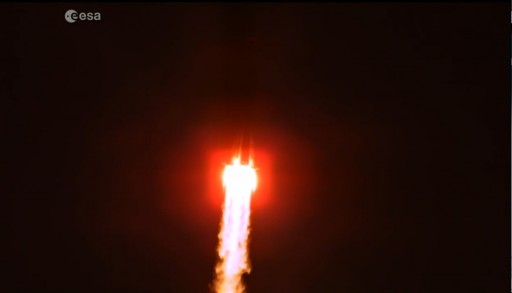
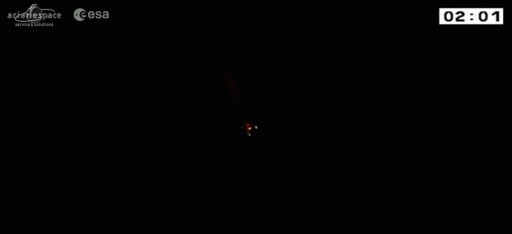
The Core Stage burned through 91,100 Kilograms of propellants over the course of its 4-minute and 45-second burn. Shutdown of the RD-108A engine cleared the way for the hot staging sequence that occurred two seconds later by igniting the RD-0124 engine of the third stage followed split seconds later by the firing of separation pyros so that the engine exhaust could push the stages apart and send the spent core towards re-entry and splashdown 1,550 Kilometers from the launch site.
Delivering 30 metric-ton-force of thrust, the modified Block I stage operated for four minutes and 27 seconds. Ten seconds into the third stage burn, the aft section covers were jettisoned to fully expose the engine compartment for proper thermal control and engine gimbal capability. Reports from the launch team continued to announce good stabilization, propulsion performance and guidance as the third stage headed into space.
The third stage burned 25,400 Kilograms of propellants, shutting down at T+9 minutes and 15 seconds – achieving the planned sub-orbital trajectory targeted for the separation of the Orbital Unit. Separation of the Fregat Upper Stage occurred nine minutes and 27 seconds after launch, marking the end of the Soyuz mission that was a complete success and signaling the start of the long Fregat mission. Over the course of over three and a half hours, Fregat was tasked with two main engine burns to boost the satellite duo into their target Medium Earth Orbit.
Immediately after separation, Fregat began using its Hydrazine-fueled Attitude Control Thrusters to enter a pre-programmed three-axis orientation to set up for main engine start. Ignition was preceded by the typical ten-second propellant settling maneuver. Lighting up its S5.92 main engine ten minutes and 24 seconds into the flight, Fregat started a very long burn that aimed for an elliptical transfer orbit.
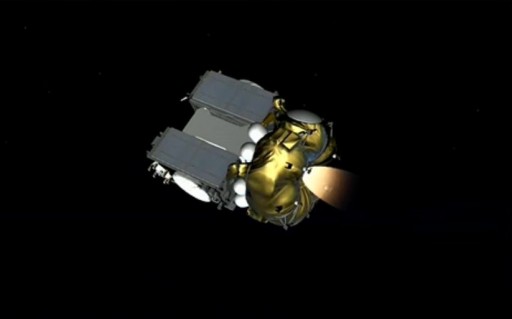
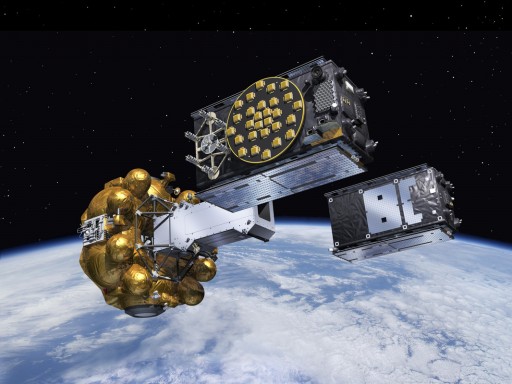
Flying in the MT configuration – its largest – the Fregat Upper Stage carried 7,100 Kilograms of storable propellants for consumption by the S5.92 engine that can operate at two thrust settings – 19.85 Kilonewtons and a reduced thrust level of 14kN while 12 hydrazine thrusters are used to deliver three-axis attitude control.
Fregat burned its engine for a little over 13 minutes, dynamically adjusting its flight profile based on data gathered with its own navigation platform to correct slight insertion errors occurring during the operation of the Soyuz rocket. The mission targeted an elliptical transfer orbit with a high point over 23,000 Kilometers in altitude and a very low perigee.
Upon completion of its long first burn, Fregat settled in for a coast phase of three hours and 15 minutes in order to climb all the way up to the apogee of the transfer orbit so that the second burn could serve as a circularization maneuver. Throughout the coast, Fregat executed pre-programmed attitude maneuvers – initiating a Passive Thermal Control roll to evenly distribute sunlight on its surface to avoid thermal gradients.
Fregat re-started its S5.92 engine three hours and 38 minutes into the flight after the usual propellant settling was conducted. The engine fired for nearly four and a half minutes, homing in on a target orbit at 23,522 Kilometers in altitude inclined 55.04 degrees. Galileo FM-5 and 6 are set to enter Plane A of the satellite constellation.
Fregat’s onboard navigation platform indicated that the stage had met its orbital insertion requirements, achieving the target orbit with the required accuracy – to be confirmed later by radio tracking of the two satellites.
Arriving in Medium Earth Orbit, Fregat conducted a re-orientation – setting up for the separation of the two satellites that was set for T+3 hours, 47 minutes and 57 seconds. Successful satellite separation was confirmed as the two departed the RUAG-built payload dispenser into opposite directions to avoid re-contact after deployment.
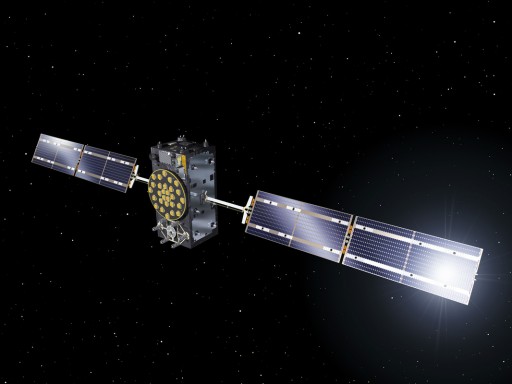
Following orbital insertion, the two spacecraft were to complete a series of pre-programmed steps that include the deployment of the solar arrays, the acquisition of a stable three-axis orientation and the initiation of communications with ground stations. The spacecraft will complete several days of initial testing before heading into commissioning and starting to transmit navigation signals for further testing.
Fregat is finishing its mission with an avoidance maneuver to move away from the satellites followed by two small engine burns that move it into a disposal orbit for passivation six hours & 55 minutes after launch.
One more Galileo satellite pair is up for launch this year to be followed by one quadruplet launches atop Ariane 5 in 2016 with another duo heading uphill on the Soyuz. For Arianespace, the launch pace continues with processing for the upcoming Ariane 5 mission currently in full swing targeting a liftoff on September 30 to loft the NBN CO 1A and Arsat 2 communications satellites. Another Ariane 5 launch is planned in early November followed by Vega’s next mission carrying the LISA Pathfinder and Soyuz to close out the year with the next Galileo launch.

